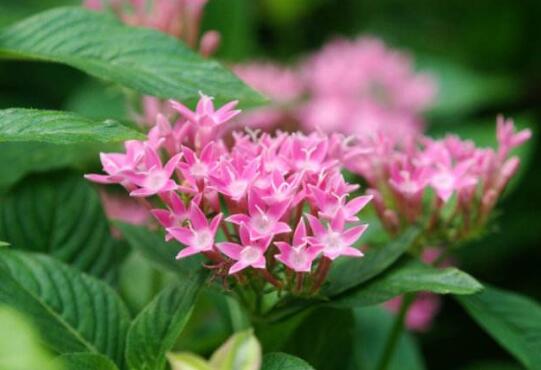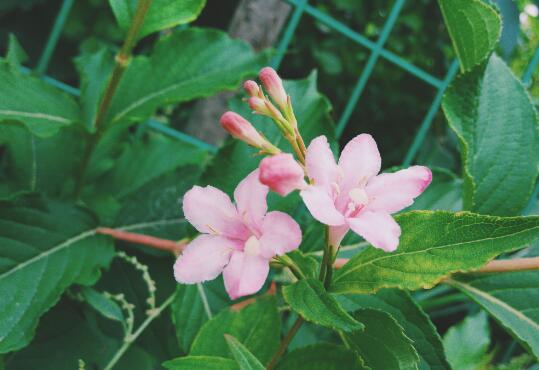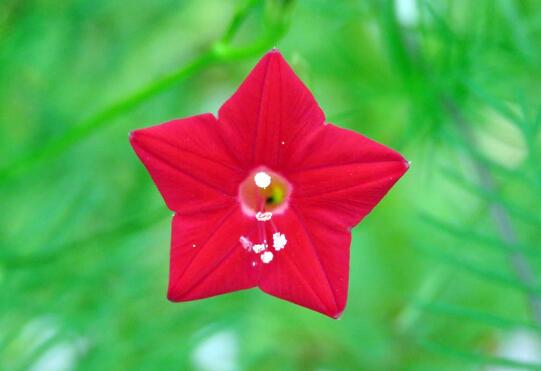How to propagate the five-star flower, the method of propagation / sowing propagation / cutting propagation
Five-star flower is a common flower plant in people's life, which has high ornamental value and can be seen in many parts of our country. As more and more people breed in various places, the question about its reproduction has also aroused people's concern. How to reproduce the five-star flower, and what are the breeding methods of the five-star flower? Next, the editor will take you to learn about it.
1. How to reproduce, sow / cut the five-star flower

When it comes to how to reproduce the five-star flower, in fact, it is mainly divided into two methods: sowing reproduction and cutting propagation. As long as the operation is proper and the process is careful, the survival rate of the two methods is very high. In the following, there are specific operation details of the two breeding methods. Interested friends can learn about it.
Second, the propagation method of five-star flower.
Sowing and reproduction
Sowing time: when we sow and reproduce the five-star flower, it is very important to choose the appropriate time. When it comes to the most suitable time to sow the five-star flower, we can choose to be in spring and autumn. The climate of these two seasons is more suitable for its growth, so the survival rate of sowing is also relatively high.
Seed reminder: we still have a pre-treatment to do before planting the five-star flower, and that is to urge its seeds. We can soak its seeds in warm water for 12-24 hours. When the seeds begin to absorb water and swell, they can be taken out and planted, which can greatly improve the survival rate and make the seeds germinate more quickly.
Sowing method: before sowing, we should flatten the selected basin soil, and then sow the seeds evenly on the soil surface. When sowing, the main row spacing is slightly larger, and after sowing, we can cover the soil with about 1-2cm for watering. When watering, we can choose a spray pot, so that watering will be more uniform, generally watering the soil moist. It can sprout in about 10-14 days after everything is done.
Cuttage propagation
Cuttings selection: before we carry on the cuttage propagation to the five-star flower, we should first choose the cuttings, generally it is best to choose the branches that grow more robust and free of diseases and insect pests as cuttings. If the branches we choose look very slender, then we can basically judge that the cuttage failed, so the selection of cuttings is a very important step.
Cutting method: among the propagation methods of five-star flower, cutting propagation is a relatively simple method. First of all, we can use chopsticks to cut a hole in the soil, and then insert the cuttings, because the branches of bare-leaf flowers are more easily damaged. If inserted directly, it is easy to hurt the roots. We can water the cuttings after we insert them, and they will take root about four or five weeks after watering.
How to grow five-star flowers, the planting method of five-star flowers / planting in spring and autumn
Among the reproduction methods of five-star flower, it is mainly divided into two methods: sowing reproduction and cutting propagation, in which sowing reproduction is a more commonly used one, and the survival rate is also very high, but if you want to plant successfully, there are many places that need to be paid attention to. about how to grow five-star flowers? What is the planting method of five-star flowers? Next, the editor will take you to learn about it.
First, how to grow five-star flowers
When it comes to how to plant five-star flowers, there are many methods that we need to pay attention to, such as the selection and disinfection of substrates, the reminder of seeds, and so on. Of course, the most important thing is to operate carefully. After all, this breeding method has been tested by countless people, and the survival rate is still quite high. As for the specific planting techniques are introduced below, let's take a look.
Second, the planting method of five-star flower
1. Planting time, spring and autumn
When we plant the five-star flower, it is very important to choose the appropriate time. When it comes to the most suitable time to sow the five-star flower, we can choose the spring and autumn seasons, the climate of these two seasons is more suitable for its growth, so the survival rate of sowing is also relatively high.
two。 The selection of matrix and good drainage
Before we plant the five-star flower, we first need to choose the substrate. Generally, it is best to choose peat soil with a little fertilizer and good drainage as the substrate, and the best pH value is 6.5-6.8, which can avoid iron poisoning and magnesium deficiency. If the pH value is lower than 6.0, the plant will stop growing due to severe leaf edge cauterization due to iron poisoning.
3. Substrate disinfection, exposure or stir-frying
After we have selected the substrate, we can not immediately carry out the seeds of the five-star flower, but also need to disinfect the substrate so that there are diseases and insect pests in it and spread it to the five-star flower. During disinfection, we can choose to break it up and lay it out in the hot sun for exposure and disinfection. You can also put it into the pan and fire and stir-fry, so that if there are pests in the soil, they will also be killed.
4. The seeds were precipitated and soaked for 12-24 hours
Before we plant the five-star flower, we still have a pre-treatment to do, and that is to urge its seeds. We can soak its seeds in warm water for 12-24 hours, and then take them out and plant them when the seeds begin to absorb and swell. This can greatly improve the survival rate, but also let the seeds germinate more quickly.
5. Planting method, germination in 10-14 days
Before planting, we have to flatten the selected basin soil, and then sow the seeds evenly on the soil surface. When sowing, the main row spacing is slightly larger, and after sowing, we can cover the soil with 1-2cm or so to water it. When watering, we can choose a spray pot, so that watering will be more uniform, generally watering to the soil moist, and after everything is done, it can be germinated in about 10-14 days.
What is pineapple? how does pineapple propagate by cutting?
Pineapple, also known as Miloson, is commonly known as pentagram flower and lion grass. The pineapple is named after the shape of the leaves, such as the feathery leaves are called pinnacles. Next, let's take a look at the breeding skills and planting of pineapple.
The pineapple is named after the shape of the leaves, such as the feathery leaves are called pinnacles. The main species used for ornamental are feather-leaf pineapple, maple leaf pineapple, round-leaf pineapple and so on. Feather leaf pineapple alias pineapple pine, round dragon flower, brocade screen, etc.; maple leaf pineapple alias big flower pineapple, bright red pineapple, palm leaf pineapple, red five star and other round leaf pineapple alias orange red pineapple.
Pineapple likes light, likes warm and humid environment, grows in an area of 0 to 2500 meters above sea level, is not cold-resistant, can self-sow (usually introduced by artificial cultivation), and requires fertile soil. Pineapple has strong resistance and easy management. The capsule contains 4 seeds, which, after maturity, falls to the ground and grows in the following year. If sown artificially, it will be sown in March. The seedlings were transplanted with a length of 10 cm. In order to bloom more, it should be planted in the fertile soil in the sunny place. Potted plants should stand on brackets for winding, and they are extremely slender and beautiful when they bloom.
Pineapple has a long flowering period, which can be from April to November every year in Hunan and Hubei provinces of China. The demand for soil fertilizer is not high, sowing seeds on wet soil can germinate, and the germination rate is more than 95%.
Pineapple is an annual weak twining herb, glabrous. Leaves ovate or oblong, 2-10cm long and 1-6cm wide, simple leaves alternate, lobes slender as silk, pinnately parted to midvein, with 10-18 pairs of linear to filiform spreading lobes, lobe apex acute; petiole 8-40mm long, base often with pseudostipules.
Inflorescences axillary, composed of Cymes of a few flowers; total pedicel mostly exceeding leaves, 1.5-10cm long, flowers erect, pedicel longer than calyx, 9-20mm longer, thickened into a stick when fruiting; sepals green, slightly unequal, elliptic to oblong spoon-shaped, outer one slightly shorter, ca. 5mm, apex obtuse and with small protuberance. Corolla salverform, ca. 2.5cm long, crimson, glabrous, tube weak, distally slightly inflated, limb spreading, ca. 1. 7-2 cm in diam. 5-lobed; stamens and style protruding; filament base hairy; ovary glabrous. On several Wuxiang star-shaped flowers, the color is deep red and bright, in addition to red, there are also white.
Capsule ovate, 7-8 mm long, 4-loculed, 4-valved, septum persistent, transparent. Seeds 4, ovate-oblong, 5-6 mm long, dark brown. The flowering period is from early July to late September, one batch opens every day, and wilts in the morning and afternoon. Capsule ovate, 7-8 mm long, 4-loculed, 4-valved, septum persistent, transparent. Seeds 4, ovate-oblong, 5-6mm long, dark brown. The slender and smooth trailing stem of pineapple, which can be up to 4-5m long, is soft and full of climbing, so it is an ideal hedge plant.
Cuttage Propagation of Prunus chinensis
It is often used for softwood cutting in late spring and early autumn, or old wood cuttings with branches from last year in early spring.
When the tender wood cuttings were carried out, the sturdy branches of the current year were selected as cuttings when the plants were growing vigorously from the end of spring to early autumn. After cutting off the branches, select the sturdy parts and cut them into segments 5-15 cm long, each with more than 3 leaf nodes. When cutting cuttings, it should be noted that the upper cut is cut flat at about 1 cm above the uppermost leaf node, and the lower cut is about 0.5 cm below the lowest leaf node, and the upper and lower cut should be flat (knife should be sharp). When hardwood cuttings are carried out, after the temperature rises in early spring, last year's robust branches are selected as cuttings. Each cuttage usually retains 3-4 nodes, and the cutting method is the same as that of softwood cuttings.
Temperature: the optimum temperature for rooting of cuttings was 20-30 ℃, which was lower than 20 ℃, and it was difficult and slow for cuttings to take root. When the temperature was higher than 30 ℃, the upper and lower cuttings were easily infected and rotted by bacteria, and the higher the temperature was, the greater the proportion of rot was. When there is a low temperature after cutting, the heat preservation measure is mainly to wrap the flowerpot or container used for cutting with thin film; when the temperature is too high after cutting, the cooling measure is mainly to shade the cuttings, to cover 50-80% of the sun, and at the same time, spray the cuttings 3-5 times a day, the higher temperature in sunny days and the higher temperature in cloudy and rainy days, the spraying times are less or no.
Humidity: the relative humidity of the air must be kept at 75-85% after cutting. The basic requirement for cuttings to take root is to ensure that cuttings are fresh and tender and can be used to produce rooting substances before they take root. However, cuttings without rooting can not absorb enough water to maintain their water balance, so it is necessary to reduce the water evaporation of cuttings by spraying: under shaded conditions, spray cuttings 3-5 times a day. The higher the temperature in sunny days, the more the times of spraying, the lower the temperature in cloudy and rainy days, the less or no spraying. But with excessive spraying, cuttings are easy to be infected by bacteria and rot, because many kinds of bacteria exist in the water.
The above is the relevant introduction of this article, I believe you have a simple understanding of this after reading it, if necessary, you can continue to pay attention to the No. 1 home network for more information.
- Prev

How to reproduce the sea immortal, the method of propagation / sowing / cutting / ramet / striping
Sea immortal is a kind of flower plant with high ornamental value, which can be seen in many parts of our country. As more and more people breed it everywhere, people are concerned about its reproduction. What are the breeding methods of sea immortals?
- Next

How to grow five-star flowers, the planting method of five-star flowers / planting in spring and autumn
Among the reproduction methods of five-star flower, it is mainly divided into two methods: sowing reproduction and cutting propagation, in which sowing reproduction is a more commonly used one, and the survival rate is also very high, but if you want to plant successfully, there are many places that need to be paid attention to. about how to grow five-star flowers? What is the planting method of five-star flowers?
Related
- Fuxing push coffee new agricultural production and marketing class: lack of small-scale processing plants
- Jujube rice field leisure farm deep ploughing Yilan for five years to create a space for organic food and play
- Nongyu Farm-A trial of organic papaya for brave women with advanced technology
- Four points for attention in the prevention and control of diseases and insect pests of edible fungi
- How to add nutrient solution to Edible Fungi
- Is there any good way to control edible fungus mites?
- Open Inoculation Technology of Edible Fungi
- Is there any clever way to use fertilizer for edible fungus in winter?
- What agents are used to kill the pathogens of edible fungi in the mushroom shed?
- Rapid drying of Edible Fungi

